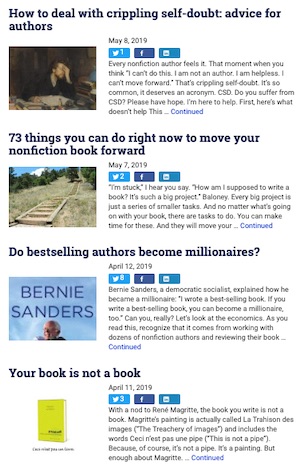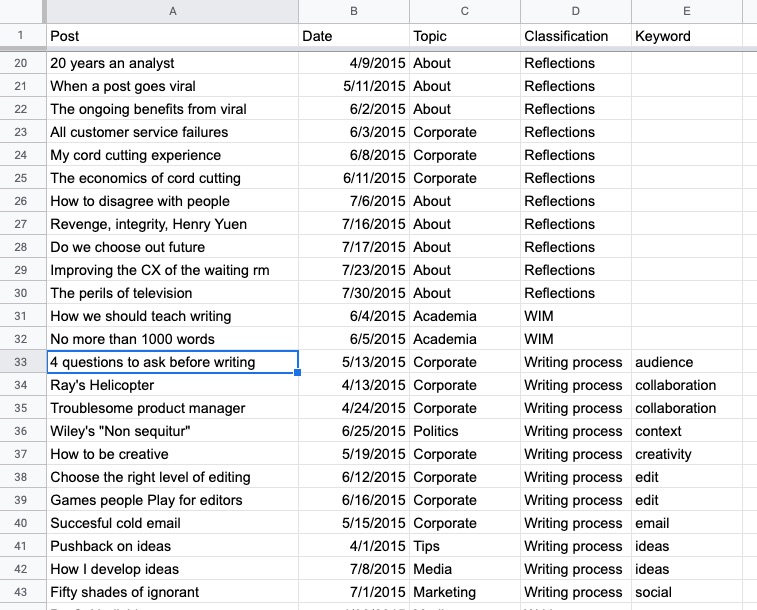Turning blog posts into a book in 6 (somewhat) easy steps

“I wrote a whole bunch of meaty blog posts. Could I make a book out of them?” That’s the seductive reasoning I hear from many clients. So let’s talk about what it takes to turn a blog into a book.
Here’s a comment that appeared on my author survey yesterday:
I write a blog, to date almost 1800 posts. It should be easy, certainly appears to be easy, to assemble them into a book, but it is not!
I also just signed up a blogger client who’s angling to turn his great ideas into a book and wants to know how. I know there are more of you out there with this same ambition. If this describes you, here are the steps to follow:
1 Compile and organize
The first step is to figure out what you have. Download a list of your posts into a spreadsheet, along with tags on each post. (I used the WordPress plugin WP All Export to help with this.) You can then classify the posts according to topics and subtopics. You’ll end up with something that looks like this:

In this listing, the “Topic” column is exported from WordPress, but the next two columns are tools I used to classify and organize the posts.
As you sort, classify, and review this spreadsheet, you’ll be able to identify which posts are useful, and what chapters or categories they might go into.
If you are a brilliant blogger, you can then just organize the posts, make a few tweaks, and publish them as a compilation book. Guy Kawasaki did this; so did Seth Godin. But let’s face it; your blog is not as good as theirs are. So you’re probably not done yet.
2 Identify strengths, weaknesses, and holes
Your next job is to turn this spreadsheet into a plan. That means taking a sharp and critical look at what you’ve got.
Delete any posts that don’t belong on the book. Narrow down the posts you will use to your best material.
Now look for holes. Which topics haven’t you covered? You’ll need to research them.
You should also look for conceptual holes. Are there enough case study stories? Have you researched third party studies or other books that bear on your topic? Are your posts too concentrated on one or two industries, or too focused on your home country?
You’ll find that what seemed like a huge collection of content about the topic is actually bunched up in some places and threadbare in other places. That’s fine. You’re still way better off than somebody who hasn’t written anything yet.
3 Work out a title, concept, and solid TOC
Now that you know what you have, what will it take to turn it into a book? Here’s where you dolly back and look at the whole picture. What is the theme of your book? How will you describe that in a simple picture? And what promises can you make to the reader about what they will gain from reading what you will compile and write?
This is the process I call “idea development.” It’s a good plan to refocus your thoughts about the book with an idea development session before you begin spackling blog posts together — otherwise your book will be more of a pastiche than a thematically unified and helpful piece of content.
Once you have the idea nailed down, write a table of contents. You should write that with the classified list of posts in front of you, but don’t let the posts determine the content. Instead, write a series of chapters in an order that makes sense, based on what the reader will need to know.
4 Write Chapter 1
You probably haven’t written the blog post that will be Chapter 1 — blog posts are smaller topics, while Chapter 1 has to lay out what your book is about. So admit that you have to do some writing from scratch here.
Remember that Chapter 1 is the “scare-the-crap-out-of-you” chapter. How will you convince the reader that they need to read the book to either avoid a big problem or reap a big payday?
5 Research and write the book
Just because you wrote a bunch of great blog posts doesn’t mean you have no content creation work left. Unless you are Kawasaki or Godin, this is when you have to line up interviews, find statistics, and generally do the same work you’d have to do for any other book: fill in the gaps in your knowledge and justification.
The difference is, you’ll be able to plug your existing blog content into many of those chapters, which puts you way ahead of those writing from scratch.
6 You’ll still have to rewrite and revise the posts
As you plop all that already-written text into your chapter, I guarantee you’ll notice that it doesn’t quite read right.
Blog posts are designed to be self-contained little nuggets of wisdom. Within chapters, they need to relate to what comes before and after.
Blog posts are generally 600 to 1500 words. That’s short for a chapter. So you’ll probably need to combine them, and may need to beef them up. Read the posts and adapt them based on the role they’re playing within the chapter you’re writing.
You may also find that you have several posts that cover the same topic. Choose the best one and use that. You can pick out bits and pieces of the rest where they support the argument. Avoid the temptation to glue together posts that cover the same topic even though you loved them as you wrote them.
Some personal reflections about the blog-to-book transformation
I wrote Writing Without Bullshit based largely on posts I’d already published. My upcoming book will also include a lot of content that appeared first on this blog.
I recommend this as a method to get great content down on paper, and get feedback on that content.
Bloggers get good at fast and fluid writing. They can turn that content into books far faster than somebody starting from square one.
Assuming you make the effort I’ve described here, you’ll probably get these three reactions from readers on the finished book:
The largest group will have never heard of your blog, and will experience the content fresh. Your reach with a book will extend far beyond the reach of your blog.
A second group will consist of your best blog readers. Most of them will welcome the book. They already value your perspective and will come to value the new material and the organization of the material into a form they can easily follow and reference.
A third, tiny group will include a few vocal people criticizing you for publishing a book of stuff they’ve already read. Don’t worry about them. Your audience in other two categories will value what you’ve done, and they’re your real target audience.
A quick reminder: There’s still time to participate in my author survey. I’ll send you a copy of the compiled results when it’s done.
Thanks Josh,
Logical and sensible advice, as always.
I was unaware of the plugin, so will go and have a look.
Then, maybe, I can have a (third) shot at a sensible assembly, as I have the central idea well sorted.